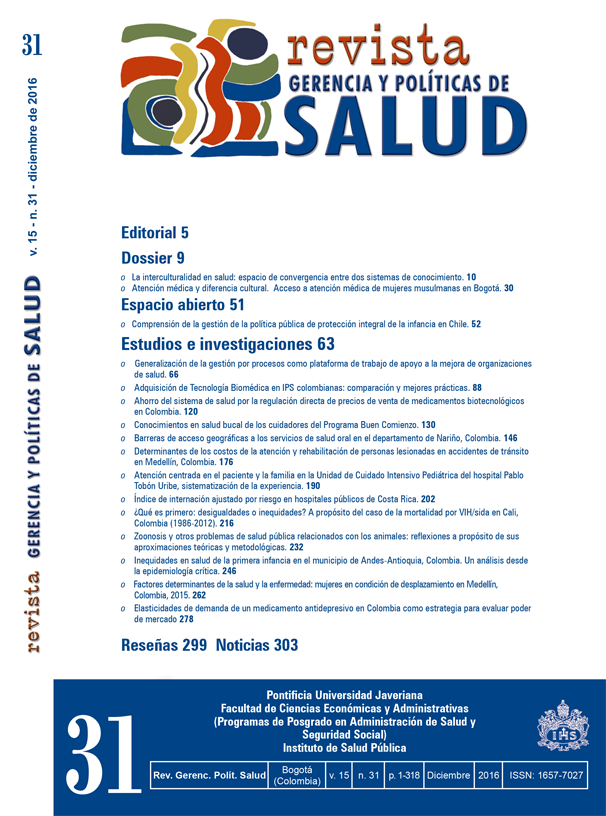Abstract
We identified the limitations and challenges in the risk approach for the understanding and intervention of zoonoses and other public health problems related to animals based on the argument that classic epidemiology – as the main discipline of public health – is insufficient as a paradigm to address the complex social nature of the relationship between nature and health. We introduce, first of all, a reflection on the prevailing models or approaches and then we present their limitations together with some of the contents of Latin American social medicine and collective health. Finally, we invite the reader to build different theoretical and methodological approaches that build upon the study of the complexity of the interface: animals, environment, and health.
2. San Martín B, Kruze J, Morales MA, Agüero H, León B, Espinoza S, et al. Resistencia bacteriana en cepas patógenas aisladas de mastitis en vacas lecheras de la V Región, Región Metropolitana y Xa Región, Chile. Arch Med Vet. 2002; 34(2):221-34.
3. Cabello FC. Antibiotics and aquaculture in Chile: Implications for human and animal health. Rev Med Chil. 2004; 132(8):1001-6.
4. Van den Bogaard AE, Stobberingh EE. Epidemiology of resistance to antibiotics: links between animals and humans. Int J Antimicrob Agents. 2000; 14(4):327-35.
5. Canul R, Garrido Vivas P. Estimación del potencial contaminante de las granjas porcinas y avícolas del estado de Yucatán. Ing Rev Académica. 2009; 13(2):13-21.
6. Murgueitio E. Impacto ambiental de la ganadería de leche en Colombia y alternativas de solución. Livest Res Rural Dev. 2003; 15(10).
7. Schwabe CV. Medicina veterinaria y salud pública. México D. F.: Editorial Novaro; 1968.
8. Quevedo E. El proceso salud-enfermedad: hacia una clínica y una epidemiología no positivistas. Seminario permanente Salud y Administración. Bogotá: Pontificia Universidad Javeriana, Facultad de Estudios Interdisciplinarios; 1990. p. 1-47
9. Rosenberg FJ. Estructura social y epidemiología veterinaria en América Latina. Boletín. 1986; 3.
10. Lalonde MA. A new perspective on the health of Canadians. Boletín Epidemiológico (Government of Canada). 1983; 4(3):13-5.
11. Arrivillaga J, Caraballo V. Medicina de la conservación. Rev Biomed. 2009; 20(1):55-67.
12. Bernard V. Un mundo, una salud. Bol OIE. 2009; 2.
13. Organización Mundial de la Salud, Comisión sobre Determinantes Sociales de la Salud. Subsanar las
desigualdades en una generación. Informe final; 2008 [Internet]. Ginebra: OMS [acceso: 22 de mayo del 2012]. Disponible en: http://whqlibdoc.who.int/publications/2009/9789243563701_spa.pdf
14. Breilh J. Epidemiología crítica: ciencia emancipadora e interculturalidad. Buenos Aires: Lugar Editorial; 2003.
15. Isaza DM, Restrepo BN, Arboleda M, Casas E, Hinestroza H, Yurgaqui T. La leishmaniasis: conocimientos y prácticas en poblaciones de la costa del Pacífico de Colombia. Rev Panam Salud Pública. 1999; 6 (3).
16. Xiang N, Shi Y, Wu J, Zhang S, Ye M, Peng Z, et al. Knowledge, attitudes and practices (KAP) relating to avian influenza in urban and rural areas of China. BMC Infect Dis. 2010; 10(1).
17. Opare C, Nsiire A, Awumbilla B, Akanmori BD. Human behavioural factors implicated in outbreaks of human anthrax in the Tamale municipality of northern Ghana. Acta Trop. 2000; 76(1):49-52.
18. Matibag GC, Kamigaki T, Kumarasiri PVR, Wijewardana TG, Kalupahana AW, Dissanayake DRA, et al. Knowledge, attitudes, and practices survey of rabies in a community in Sri Lanka. Environ Health Prev Med. 2007;12(2):84-9.
19. Breilh J, Muñoz YT. Aceleración global y despojo en Ecuador: el retroceso del derecho a la salud en la era neoliberal. Quito: Universidad Andina Simón Bolívar; 2009.
20. Quevedo V, Hernández A. La articulación del conocimiento básico biológico y social en la formación del profesional de la salud: una mirada desde la historia. En: Desarrollo de recursos humanos. Washington D. C.: OPS; 1994. p. 13-34.
21. Idrovo ÁJ, Eslava JC, Rodríguez JM, Ruíz-Rodríguez M. La otra transición epidemiológica: hitos en el desarrollo de la epidemiología de los factores de riesgo en Colombia. Biomédica. 2008; 28(4):480-96.
22. Organización Panamericana de la Salud (OPS), Organización Mundial de la Salud (OMS). Reunión Interamericana a Nivel Ministerial en Salud y Agricultura, RIMSA. Informe del programa de Salud Pública Veterinaria de la OPS sobre el cumplimiento de las orientaciones estratégicas y programáticas-OEP.1999-2000. San Pablo, Brasil: OPS, OMS; 2001.
23. Schneider MC. Reflexión sobre los modelos para el estudio de los brotes de rabia humana por murciélago.
Cad Saude Publica. 1995; 11(2): 291-304.
24. Acero A, Caro R, Ivonne M, Henao K, Ruiz E, Luisa F, et al. Determinantes sociales de la salud: postura oficial y perspectivas críticas. Rev Fac Nac Salud Pública. 2013; 31: 103-10
Copyright notice
The Journal Management and Health Policies is registered under the Creative Commons Recognition 4.0 International license. Therefore, this work can be reproduced, distributed and publicly communicated in digital format, provided that the name of the authors and the Pontificia Universidad Javeriana are recognized. It is allowed to quote, adapt, transform, autoarchive, republish and create from the material, for any purpose (including commercial), provided that authorship is properly acknowledged, a link to the original work is provided and if changes have been mad. The Pontificia Universidad Javeriana does not retain the rights over published works and the contents are the exclusive responsibility of the authors, who preserve their moral, intellectual, privacy and publicity rights.
The endorsement of the intervention of the work (revision, style correction, translation, layout) and its subsequent disclosure is granted through a license to use and not through a transfer of rights, which means that the journal and the Pontificia Universidad Javeriana disclaims any liability that may arise from ethical misconduct on the part of the authors. As a result of the protection provided by the license for use, the journal is not obliged to publish retractions or modify the information already published, unless the erratum arises from the process of editorial management. The publication of contents in this magazine does not represent royalties for taxpayers.


